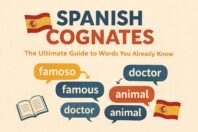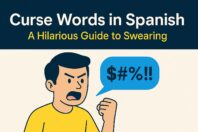Shopping in Spanish: Vocab for a successful shopping experience

Get our free email course, Shortcut to Conversational.
Have conversations faster, understand people when they speak fast, and other tested tips to learn faster.
More infoShopping is one of the few activities that everyone does at some point. When we visit a new place for the first time, we always want to check out the local shops and go shopping to get everything we need on our trip, or maybe to bring a souvenir home. This is especially true if we are visiting a foreign country, so it’s important you know how to go shopping in Spanish.
When you visit the shops and make your purchases, you can do it with confidence, just as a local would. However, to achieve a successful shopping day, we need to master the necessary phrases and vocabulary to blend in with the locals.
This post will teach you all the necessary Spanish shopping vocabulary, from finding the right shops and items, to bargaining and paying for them.
So are you ready to go shopping in Spanish? Let’s get started!
Finding the Right Shop
When visiting Spanish-speaking countries, you may need to find some essential supplies, a couple of souvenirs, or even some new clothes.
So what types of stores are you looking for? Depending on whether you’re in a city or in the countryside, you’ll find a massive selection of stores to choose between. Some of them even seem to sell everything all in one spot, from groceries to household equipment, while others are more specialized.
We’ll start off our post by helping you to find what kinds of stores you’re looking for, and where they’re located.
Types of stores
Tipos de tiendas
When looking for a store you already have in mind, you can always look for the signs on the street, or even inside a mall. You can also ask a local using some of the Spanish store vocab we present here.
- Excuse me, do you know where I can find a …? – Disculpe, ¿sabe dónde puedo encontrar …?
| Boutique | Un boutique |
| Mall | Un centro comercial |
| Market | Un mercado |
| Supermarket | Un supermercado |
| Grocery store | Una tienda de comestibles |
| Fruit and vegetable market | Una frutería, Una verdulería |
| Butcher’s shop, Butcher market | Una carnicería, Un mercado de carnes |
| Fish stand | Una pescadería |
| Bakery | Una panadería |
| Cake shop, Pastry shop | Una repostería |
| Café | Una cafetería |
| Liquor store | Una licorería |
| Pharmacy | Una farmacia |
| Hair salon | Una peluquería |
| Jewelry store | Una joyería |
| Clothing store | Una tienda de ropa |
| Shoe store | Una zapatería |
| Flower shop | Una florería |
| Toy store | Una juguetería |
| Book store | Una librería |
| Sports store | Una tienda de deportes |
| Music store | Una tienda de música |
| Hardware store | Una ferretería |
| Travel agency | Una agencia de viajes |
| Gas station | Una gasolinera |
We’ve gone through a lot of the most common types of stores here. Some good news is that in Latin America, gasolineras don’t only sell gas, but are also good places to go for bathrooms, cash machines, and more. Also, keep in mind that una librería in Spanish is a bookstore, not to be confused with una biblioteca, which is a library in Spanish.
If you’re looking to go a bit farther in a city, we recommend our detailed post on how to ask directions in Spanish.
Signs and locations
Letreros y ubicaciónes
Now that you’ve found the store you were looking for, you’ll need to navigate its different sections. In this list we cover all the vocab you need for getting around a shop in Spanish!
| Push | Empuje |
| Pull | Hale |
| Entrance | La entrada |
| Exit | La salida |
| Aisles | Los pasillos |
| Stand | El puesto |
| Basement | La planta sótano |
| Ground floor | La planta baja |
| First floor | La primera planta |
| Second floor | La segunda planta |
| Third floor | La tercera planta |
| Fitting Room | El probador |
| Manager | El / La gerente |
| Business hours | El horario de atención |
| Open | Abierto |
| Closed | Cerrado |
Where to buy
Dónde comprar
If you know what you’re looking for but don’t know where to find it, you’ll want to ask someone for information. The following questions will surely help you find what you need!
Remember that it’s polite to use the usted form of you in Spanish when approaching a stranger, so all of these phrases use this third-person singular conjugation.
- Where can I buy a …? – ¿Dónde puedo comprar un/una …?
- Do you know a place where they do …? – ¿Conoce un lugar donde realizan …?
- Do you know where they sell …? – ¿Conoce un lugar donde venden …?
- Do you know of a … around here? – ¿Conoce algún … por aquí cerca?
- Where is the closest / cheapest / coolest clothing store? – ¿Dónde queda la tienda de ropa más cercana / económica / chévere?
- Which one do you recommend to me? – ¿Cuál me recomienda?
Asking about products in Spanish
Once you’ve found your store, you’re ready to start shopping in Spanish. In the following sections we’ll introduce the vocab to help you find the items you’re looking for, along with some details on their quality so you can choose the right one!
Items
Los artículos
Let’s start broad, getting you to the right section of a big mall or store for whatever you’re looking to buy.
| Clothing and shoes | Ropa y zapatos |
| Lingerie, Underwear | Lencería, Ropa interior |
| Jewelry | Joyería, Joyas |
| Babies | Bebés |
| Personal hygiene products | Productos de higiene personal |
| Cosmetics | Cosméticos |
| Pet items | Artículos para mascotas |
| Toys | Juguetes |
| Kitchenware | Artículos de cocina |
| China and glassware | Porcelana y cristalería |
| Groceries | Comestibles |
| Vegetables | Vegetales, Verduras |
| Fruits | Frutas |
| Dairy products | Productos lácteos |
| Gardening items | Artículos para jardinería |
| Office supplies | Artículos de oficina |
| Electronics | Artículos electrónicos |
| Appliances | Electrodomésticos |
| Furniture | Muebles |
| Tools | Herramientas |
Quality
La calidad
Now we can start talking about what we’re looking for in a certain product, or what we think of what we find. Here we present the standard Spanish adjectives for describing a product, from cheap to elegant.
Remember that the adjectives need to match the gender and number of whatever they’re describing, so change the final -o to -a if the item is feminine. For a full grammar explanation, see our post on using Spanish adjectives.
Of course there are plenty of other words to describe things, so we’ll send you to our bigger posts on Spanish adjectives and colors in Spanish to get those details. The words we focus on here pertain to our Three Bs mantra for shopping in Spanish: Las tres B son Bueno, Bonito y Barato, meaning good, nice, and cheap!
| Cheap | Barato |
| Affordable | Económico |
| Expensive | Caro |
| Pretty | Bonito |
| Elegant | Elegante |
| Ugly | Feo |
| Good | Bueno |
| Luxury | Lujoso |
Material
El material
In addition to the quality, many items can have different origins. Let’s see some of the Spanish words for materials and origins so you can narrow down your selection. Again, remember to modify the adjectives so they match the gender and number of whatever they’re describing!
- What material is it made of? – ¿De qué material es?
- What type of fabric is this? – ¿Qué tipo de tela es?
- I think we should buy it. – Creo que deberíamos comprarla.
| Organic | Orgánico |
| Handmade | Hecho a mano |
| Homemade | Casero |
| Carved | Tallado |
| Fitted | Ajustable |
| Sewn | Cosido |
| Knitted | Tejido |
| Ceramic | Cerámico |
| Porcelain | Porcelana |
| Fiber | Fibra |
| Cotton | Algodón |
| Leather | Cuero |
| Flannel | Franela |
| Wool | Lana |
| Lycra | Licra |
| Velvet | Terciopelo |
| Made in … | Hecho en … |
Specialized Spanish shopping vocabulary
So far we’ve kept our post pretty general, so you can apply most of the vocab in a wide assortment of shops. If you want to get into specific detail though, you might be interested in more vocab for a given interest. Here we list some of our dedicated posts that introduce all the vocab you might need when you’re shopping for these activities!
Ordering food at a restaurant in Spanish
Clothes shopping in Spanish
A lot of the words we’ve seen so far can be applied to all sorts of items, whereas for clothing we need some additional vocabulary. Let’s start with a Spanish sizing chart, and then get into some questions you can ask once you’re ready to try on an item of clothing.
Size
La talla
Many clothing tags will be familiar to you, but in case they’re only in Spanish, here’s the sizing information you’re likely to find.
| Small size (S) | Talla pequeña (P) |
| Medium size (M) | Talla mediana (M) |
| Large size (L) | Talla grande (G) |
| Extra large size (XL) | Talla extra grande (XG) |
| One size fits all | Talla única |
A helpful tip when shopping in Spanish is to know your sizes ahead of time. It’s especially useful to know the length of your feet in centimeters, since this is how shoes are sized in many Spanish-speaking countries!
All right! Now let’s head to the fitting rooms.
Try it on!
¡Pruébatelo!
Sizing can be tricky when we are trying new brands, so grab your items and try them on in the probadores, or fitting rooms! Here we present a selection of useful phrases that you can use to interact with the sales staff and find the perfect clothes! Of course, some simple Spanish greetings can also come in handy.
- Please, can you help me? – Por favor, ¿me puede ayudar?
- Welcome! May I help you? – ¡Bienvenido/a! ¿Puedo ayudarle?
- Are you looking for anything in particular? – ¿Busca algo en especial?
- Where are the fitting rooms? – ¿Dónde están los probadores?
- Can I try this on? – ¿Puedo probarme esto?
- Do you have this in … size? – ¿Tiene este en talla … ?
- It fits me well. – Me queda bien.
- It doesn’t fit me. – No me queda.
- It’s too big on me. – Me queda muy grande.
- It’s too tight here. – Me queda ajustado aquí.
- My shoe size is … – Mi talla de zapatos es …
- Do you have this one in another color? – ¿Tiene este en otro color?
- It’s sold out. – Está agotado/a.
- Are you going to take it? – ¿Se lo lleva?
- No, thank you. – No, gracias.
- I’ll think about it. – Lo voy a pensar.
- I’m not sure. – No estoy seguro/a.
- I’m going to keep looking. – Voy a seguir buscando.
- I’m just looking, thanks. – Solo estoy mirando, gracias.
- I would like one of those, please. – Quisiera uno de esos, por favor.
- Thank you very much, sir / ma’am. – Muchas gracias, señor/a.
- I want this one / that one. – Quiero este / ese.
- I don’t like this one so much. – Este/a no me gusta tanto.
- I really like this one! – ¡Me encanta este/a!
- Where can I find …? – ¿Dónde puedo encontrar …?
- In aisle number … – En el pasillo …
- I’ll take it! – ¡Me lo llevo!
Paying for your purchases
Once you’ve found the items you want to buy, it’s time to pay for them. In the next sections we’ll cover the most important interactions you’ll have at the checkout counter, we’ll cover essential money vocab, and we’ll even provide some pointers for bargaining in Spanish.
Checkout phrases
Frases útiles de pago
Here we present some of the most common phrases you’ll need when it’s time to pay for your items. When you’re talking about prices, be sure to know your numbers in Spanish!
- How much does it cost? – ¿Cuánto cuesta?
- How much is this one? – ¿Cuánto cuesta este?
- How much in dollars? How much in pesos? How much in euros? – ¿Cuántos dólares? ¿Cuántos pesos? ¿Cuántos euros?
- Does it have a discount? – ¿Tiene descuento?
- On sale. – En oferta.
- Where is the cash register? – ¿Dónde está la caja registradora?
- Do you take credit cards? – ¿Acepta tarjeta?
- Cash only. – Sólo efectivo.
- I don’t have change. – No tengo cambio.
- Don’t you have a smaller bill? – ¿No tiene un billete más pequeño?
- Don’t you have change for …? – ¿No tiene cambio para …?
- Can you give me change for a $… bill? – ¿Me puede cambiar un billete de $…?
- What is the exchange rate? – ¿Cuál es la tasa de cambio?
- Would you like a bag? – ¿Desea una bolsa? – ¿Quiere una bolsa?
- No bag, please. – Sin bolsa, por favor.
- Yes, I need a bag, please. – Sí, necesito una bolsa, por favor.
Money
El dinero
Here we present the basic vocab you’ll need when you go to pay for your items. For an even broader introduction to this topic, check out our post on money in Spanish slang.
| Money | El dinero |
| Cash | El efectivo |
| Bills | Los billetes |
| Coins | Las monedas |
| Currency | La moneda |
| Exchange rate | La tasa de cambio |
| Change | El cambio |
| Credit card | Una tarjeta de crédito |
| Debit card | Una tarjeta de débito |
| Wire transfer | Una transferencia bancaria |
| Point of sale | El punto de venta |
| Dollars | Los dólares |
| Euros | Los euros |
| Pesos | Los pesos |
Bargaining in Spanish
Negociando en español
A lot of shops in Latin America have fixed prices, but sometimes there’s room for negotiation. This is especially the case in touristy areas, or in markets.
With this in mind, let’s wrap up our post on shopping with some useful phrases for bargaining in Spanish. Just remember that this is a back-and-forth process, and neither the buyer nor the seller is obligated to change their offer. Keep it polite, and be ready to walk away if you’re not happy or if the bargaining isn’t going as you’d hoped.
But as long as you’re able to do some of the bargaining in Spanish, you should also be ready to get a better deal on whatever you’re shopping for!
You can start your approach with the salesperson with this question:
- How much are you asking for …? – ¿Cuánto pide por …?
The straight answer from the salesperson would be along the lines of:
- Give me $… – Deme $…
Now it’s your turn! Choose between these phrases to convey your mood on the proposed price, or to make a counteroffer:
- It’s too expensive! – ¡Es demasiado caro!
- I’ll give you $… – Le doy $…
- I have $… – Tengo $…
- I don’t have more money. – No tengo más dinero.
- It’s all I have. – Es lo único que tengo.
Sometimes you can try for a better price if you buy more than one item. Here are some phrases in case you want to try this approach:
- And what if I take …? – ¿Y si me llevo …?
- What price would you give me for them? – ¿En cuánto me los deja?
Once you and the salesperson make your offers and counteroffers, it’s time to make a decision. Do you buy the items at that price, or do you walk away? Hopefully you’re both happy with the final price, and you can conclude the sale!
Conclusion: Shopping in Spanish
Well this has been a fun Spanish shopping excursion!
Today’s post covered all the different steps you’ll need for a successful shopping mission in a Spanish-speaking country, from finding a shop to locating the right items, to trying them on and paying. We also provided plenty of links to our other lessons in case you want specialized vocab for specific activities.
Overall, we thank you for shopping for us, and we look forward to seeing you back for more next time!



